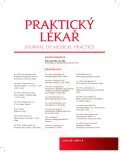Analysis of the most common food-and water-borne diseases in the Czech Republic, 2007–2017
Authors:
M. Špačková 1; M. Gašpárek 2
Authors‘ workplace:
Státní zdravotní ústav, Praha, Oddělení epidemiologie infekčních nemocí, Centrum epidemiologie a mikrobiologie, Vedoucí: MUDr. Jan Kynčl, PhD.
1; Národní referenční centrum pro analýzu epidemiologických dat, Oddělení biostatistiky, Vedoucí: RNDr. Marek Malý, CSc.
2
Published in:
Prakt. Lék. 2018; 98(6): 260-265
Category:
Of different specialties
Overview
Aim:
Analysis of trends and other main epidemiological characteristics of the most prevalent food-and water-borne diseases in the Czech Republic in the years 2007–2017.
Methods:
We performed descriptive analysis of most prevalent food-and water-borne diseases in the Czech Republic in the years 2007–2017. The data used for the analysis were taken from Czech National Electronic Surveillance System called EpiDat.
Results:
The most common food-and water-borne diseases captured within the Czech National Electronic Surveillance System with the highest number of cases reported per year were campylobacteriosis (total 232 380 cases), salmonelosis (total 127 788 cases) and viral gastrointestinal infections (total 99 631 cases) caused mainly by rotaviruses and noroviruses. The epidemiological trends changed only slightly in the analyzed years. No significant differences were observed.
Conclusions:
The epidemiological trends of the most common food-and water-borne diseases in the Czech Republic changed only slightly in the years 2007–2017. Main prevention measures for food-and water-borne diseases control in the Czech Republic remains the same with special attention to the risk groups, particularly immunocompromised and children younger than 5 years old.
KEYWORDS:
food-and water-borne diseases – salmonellosis – campylobacteriosis – rotavirus infections – norovirus infections
Sources
1. Kirk MD, Pires SM, Black RE, et al. World Health Organization estimates of the global and regional disease burden of 22 foodborne bacterial, protozoal, and viral diseases, 2010: a data synthesis. PLoS medicine 2015; 12(12): e1001921.
2. Hansson I, Sandberg M, Habib I, et al. Knowledge gaps in control of Campylobacter for prevention of campylobacteriosis. Transbound Emerg Dis 2018; 65(Suppl 1): 30–48.
3. Nichols GL, Richardson JF, Sheppard SK, et al. Campylobacter epidemiology: a descriptive study reviewing 1 million cases in England and Wales between 1989 and 2011. BMJ open 2012; 2(4): e001179.
4. Allan PD, Palmer C, Chan F, et al. Food safety labelling of chicken to prevent campylobacteriosis: consumer expectations and current practices. BMC Public Health 2018; 18(1): 414.
5. EFSA. The European Union summary report on trends and sources of zoonoses, zoonotic agents and food-borne outbreaks in 2016. EFSA J 2017; 15(12): 5077.
6. Hsieh Y-H, Sulaiman IM. Campylobacteriosis: An emerging infectious foodborne disease. In: Holban AM, Grumezescu AM. (eds.) Handbook of Food Bioengineering, vol. 15, Foodborne Diseases. New York: Elsevier 2018; 119–155.
7. Beneš J. Infekční lékařství. Praha: Galén 2009.
8. Lamas A, Miranda JM, Regal P, et al. A comprehensive review of non-enterica subspecies of Salmonella enterica. Microbiol Res 2018; 206: 60–73.
9. Riera-Montes M, O’Ryan M, Verstraeten T. Norovirus and Rotavirus disease severity in children: systematic review and meta-analysis. Pediatr Infect Dis J 2018; 37(6): 501–505.
10. Wang P, Goggins WB, Chan EY. A time-series study of the association of rainfall, relative humidity and ambient temperature with hospitalizations for rotavirus and norovirus infection among children in Hong Kong. Sci Total Environ 2018; 643: 414–422.
11. van Damme P, Giaquinto C, Huet F, et al. Multicenter prospective study of the burden of rotavirus acute gastroenteritis in Europe, 2004–2005: the REVEAL study. J Infect Dis 2007; 195(Suppl.1): S4–S16.
12. van Beek J, de Graaf M, Al-Hello H, et al. Molecular surveillance of norovirus, 2005–16: an epidemiological analysis of data collected from the NoroNet network. Lancet Infect Dis 2018; 18(5): 545–553.
13. Lindsay L, Wolter J, de Coster I, et al. A decade of norovirus disease risk among older adults in upper-middle and high income countries: a systematic review. BMC Infect Dis 2015; 15(1): 425.
14. Jarolímek J, Mrkos P. Havárie vodovodu v pražských Dejvicích – rok poté z pohledu Hygienické stanice hlavního města Prahy a PVK 2016 [online]. Dostupné z: http//www.hygpraha.cz/dokumenty/havarie-vodovodu-v-prazskych-dejvicich---rok-pote-z-pohledu-hygienicke-stanice-hlavniho-mesta-prahy-2541_2541_161_1.html [cit. 2018-08-24].
15. Chlíbek R. Očkování dospělých. Praha: Mladá fronta 2018.
16. Werber D, Michaelis K, Hausner M, et al. Ongoing outbreaks of hepatitis A among men who have sex with men (MSM), Berlin, November 2016 to January 2017 – linked to other German cities and European countries. Euro Surveill 2017; 22(5): 30457.
17. Freidl GS, Sonder GJ, Bovée LP, et al. Hepatitis A outbreak among men who have sex with men (MSM) predominantly linked with the EuroPride, the Netherlands, July 2016 to February 2017. Euro Surveill 2017; 22(8): 30468.
18. Kuhn K, Nielsen E, Mølbak K, Ethelberg S. Epidemiology of campylobacteriosis in Denmark 2000–2015. Zoonoses Public Health 2018; 65(1): 59–66.
19. Schielke A, Rosner BM, Stark K. Epidemiology of campylobacteriosis in Germany – insights from 10 years of surveillance. BMC Infect Dis 2014; 14(1): 30.
20. Skirrow M. A demographic survey of campylobacter, salmonella and shigella infections in England: a Public Health Laboratory Service survey. Epidemiol Infect 1987; 99(3): 647–657.
Labels
General practitioner for children and adolescents General practitioner for adultsArticle was published in
General Practitioner

2018 Issue 6
Most read in this issue
- Dark lesions in the oral cavity – differential diagnosis
- Surrogacy in the Czech Republic: current status and the responsibility of the general practicioner
- Use of telerehabilitation as a complement to regular rehabilitation care
- Analysis of the most common food-and water-borne diseases in the Czech Republic, 2007–2017
